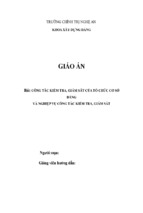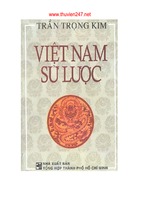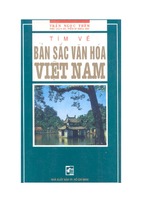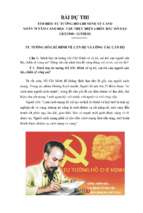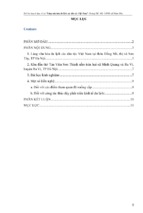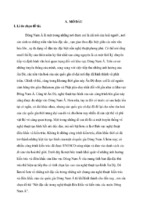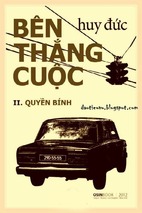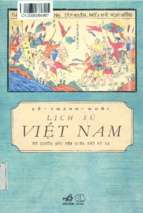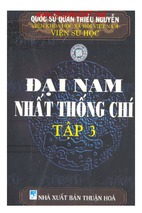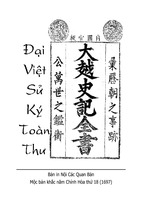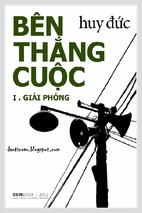Daily life in Asia’s newest mega-urban region
ABOUT THE AUTHOR
Catherine Earl is a social anthropologist and research fellow at Federation
Business School, Federation University Australia. She is frequent visitor
to Vietnam and she has published on social mobility, social welfare and
social change in Vietnam and in Australia
GENDERING A SIA
a series on gender intersections
www.niaspress.dk
Earl-pbk-cover.indd 1
EARL VIETNAM’S NEW MIDDLE CLASSES
Vietnam has been transformed over the past quarter of a century by massive industrialization and urbanization that followed
macro-economic reforms introduced from the late 1980s. This
volume explores the social consequences of this change by delving
into the lives and aspirations of young women graduates who have
come to Ho Chi Minh City in search of success in the city’s growing graduate labour market. They are part of Vietnam’s new middle
class, an educated and affluent segment of society growing with
the rapid urbanization of Vietnam’s major cities. This rich, personcentred ethnography argues that the country’s mega-urban Southeast region enables young women, so long as they remain single,
to realize aspirations for betterment that affect not only their own
lives, but those of their families and communities who remain in
rural Vietnam. It thus highlights the important social role of remittances and the salience of kinship during periods of social transformation. The volume concludes with a wide-ranging look at the
emergence of middle classes in Pacific Asia in order to locate the
Vietnamese new middle class within a globalizing context.
VIETNAM’S NEW
MIDDLE CLASSES
Gender, Career, City
CATHERINE EARL
10/07/2014 18:50
VIETNAM’S NEW MIDDLE CL A SSES
Earl book final.indd 1
11/07/2014 17:11
GENDERING ASIA
A Series on Gender Intersections
Gendering Asia is a well-established and exciting series addressing the ways in which
power and constructions of gender, sex, sexuality and the body intersect with one
another and pervade contemporary Asian societies. The series invites discussion of
how people shape their identities as females or males and, at the same time, become
shaped by the very societies in which they live. The series is concerned with the
region as a whole in order to capture the wide range of understandings and practices
that are found in East, Southeast and South Asian societies with respect to gendered
roles and relations in various social, political, religious, and economic contexts.
As a multidisciplinary series, Gendering Asia explores theoretical, empirical and
methodological issues in the social sciences.
Series Editors: Wil Burghoorn, Gothenburg University; Cecilia Milwertz, NIAS; and
Helle Rydstrøm, Lund University (contact details at: http://www.niaspress.dk).
1. Working and Mothering in Asia. Images, Ideologies and Identities, edited by Theresa
W. Devasahayam and Brenda S.A. Yeoh
2. Making Fields of Merit. Buddhist Female Ascetics and Gendered Orders in Thailand, by
Monica Lindberg Falk
3. Gender Politics in Asia. Women Manoeuvring within Dominant Gender Orders, edited
by Wil Burghoorn, Kazuki Iwanaga, Cecilia Milwertz and Qi Wang
4. Lost Goddesses. The Denial of Female Power in Cambodian History, by Trudy Jacobsen
5 Gendered Inequalities in Asia. Configuring, Contesting and Recognizing Women and
Men, edited by Helle Rydstrøm
6. Submitting to God. Women and Islam in Urban Malaysia, by Sylva Frisk
7. The Authority of Influence. Women and Power in Burmese History, by Jessica Harriden
8. Beyond the Singapore Girl. Discourses of Gender and Nation in Singapore, by Chris
Hudson
9. Vietnam’s New Middle Classes: Gender, Career, City by Catherine Earl
NIAS Press is the autonomous publishing arm of NIAS – Nordic Institute of Asian Studies,
a research institute located at the University of Copenhagen. NIAS is partially funded by the
governments of Denmark, Finland, Iceland, Norway and Sweden via the Nordic Council
of Ministers, and works to encourage and support Asian studies in the Nordic countries. In
so doing, NIAS has been publishing books since 1969, with more than two hundred titles
produced in the past few years.
UNIVERSITY OF COPENHAGEN
Earl book final.indd 2
Nordic Council of Ministers
11/07/2014 17:11
VIETNAM’S
NEW MIDDLE
CL A S S E S
Gender, Career, City
CATHERINE EARL
Earl book final.indd 3
11/07/2014 17:11
Nordic Institute of Asian Studies
Gendering Asia series, no. 9
First published in 2014 by NIAS Press
NIAS – Nordic Institute of Asian Studies
Øster Farimagsgade 5, 1353 Copenhagen K, Denmark
Tel: +45 3532 9501 • Fax: +45 3532 9549
E-mail:
[email protected] • Online: www.niaspress.dk
© Catherine Earl 2014
A CIP catalogue record for this book is available from the British Library
ISBN: 978-87-7694-145-1 (hbk)
ISBN: 978-87-7694-146-8 (pbk)
Typeset in Arno Pro 12/14.4 Typesetting by Lene Jakobsen
Printed in Great Britain by Marston Book Services Limited, Oxfordshire
Cover illustrations: (behind) ‘300th anniversary of Saigon/Ho Chi Minh City’,
a billboard designed by Phan Hoai Phi (from ‘Tranh cổ động’ [Propaganda
posters], Trường Đại học Mỹ thuật Thành phố Hồ Chí Minh, 2000); and
(front) reworking of an image by an unknown artist (all efforts to locate the
artist have failed but we would be happy to hear from him/her).
Earl book final.indd 4
11/07/2014 17:11
Contents
Acknowledgements vii
1. Middle classes in post-reform Ho Chi Minh City 1
2. Urban middle classes in postcolonial Saigon 49
3. Living in twenty-first century Ho Chi Minh City 87
4. Lifestyles of professional work 109
5. New middle-class leisure culture 135
6. Social mobility in a multi-dimensional family 172
7. Delaying and desiring marriage 209
8. Conclusion 240
References 271
Index 302
Earl book final.indd 5
11/07/2014 17:11
Earl book final.indd 6
11/07/2014 17:11
Acknowledgements
T
his research began as a doctoral project at Victoria University
in Australia. The fieldwork was funded by grants from the
Department of Asian and International Studies and the Secomb
Travel Fund at Victoria University, and the Australian Federation of
University Women E. M. Hinder Bursary for Research in Southeast
Asia. In Ho Chi Minh City, my research was hosted initially by the
Faculty of Oriental Studies and later by the Department of Sociology
at the University of Social Sciences and Humanities, Vietnam National
University. The Nordic Institute of Asian Studies hosted me during the
preparation of the manuscript. I am indebted to Mark Stevenson, Marc
Askew, Phan Văn Giưỡng, Bùi Khánh Thế, Philip Taylor, Ngan Collins,
Nguyễn Hồng Xoan, Trần Phi Phượng, Irina Vasilenka, Anastasia Sai,
Noni Basalama, Minna Hakkarainen, and Adam Fforde who provided
inspiration, motivation, criticism and humour throughout the project.
My thanks go to my fabulous editors at NIAS Press Gerald Jackson and
Leena Höskuldsson who made the process seamless. Most importantly,
I acknowledge my informants in Ho Chi Minh City and the willingness
with which they participated in the research. I am grateful for the support of my family and friends in Australia, Vietnam and Denmark who
accommodated and sustained me throughout the project.
Earlier versions of sections in chapters 1, 2, 4, 5 and 7 have appeared
in ‘Cosmopolitan or Cultural Dissonance? Middle-Class Encounters
with the Other’, in Marika Vicziany and Robert Cribb (eds), Proceedings
of the 17th Biennial Conference of the Asian Studies Association of Australia,
Melbourne, Australia: Is this the Asian Century? Melbourne: Monash Asia
Institute, Monash University, 2008, pp. 1–15; ‘Post-War Mobilities:
Gender, Poverty and Opportunity in Vietnam’s Third Wave of Mass
Urban Migration’, Children in War: The International Journal of Evacuee
and War Child Studies, Vol. 1, No. 10, May 2013, pp. 71–6; and ‘Vietnam’s
“Informal Public” Spaces: Belonging and Social Distance in Post-Reform
Ho Chi Minh City’, Journal of Vietnamese Studies, Vol. 5, No. 1, February
2010, pp. 86–124.
vii
Earl book final.indd 7
11/07/2014 17:11
Earl book final.indd 8
11/07/2014 17:11
CHAPTER ONE
Middle classes in post-reform
Ho Chi Minh City
I
n 1998 I arrived in Ho Chi Minh City for a Vietnamese language
course and was immediately struck by the number of communist
slogans in yellow capitals on red banners strung across the major
streets. The banners were not an everyday decoration but celebrated
300 years of Vietnamese settlement in Saigon. A number of colourful
billboards also decorated the street corners at major intersections.
Waiting on my bicycle in the traffic, I noticed a billboard that depicted
Vietnamese society on the occasion of the 300th anniversary. A line of
eight citizens facing a sketched cityscape – modern and progressive concrete buildings and a parked car – exemplified Ho Chi Minh City society.
At the back stood a young trio: the men in a shirt and tie and the woman
in a plain blue áo dài traditional dress, the typical uniforms of state employees at that time. In front of them, in the middle of the group stood
a male civil servant in a khaki uniform and a female agricultural worker
in a black áo bà ba peasant blouse, a sheath of rice in her arms. At the
front of the group stood a construction worker in an orange boiler suit, a
scientist carrying his technical books, and a schoolgirl in a blue uniform
with a knotted red neck scarf. It was the prominence of the skilled and
educated at the forefront of society and the centre of the billboard that
was striking. In the 1990s, contributions of educated young women had
become so important in the post-reform urban economy that positive
aspects of đổi mới, the nation-wide macro-economic reform introduced
in 1986, were symbolized by images of middle-class urban schoolgirls
(nữ sinh) representing youth, mobility, modernity, cultural vitality and
pride (Werner 2002, p. 41).
Symbolizing the future progress and development of Vietnamese
society through the image of a hard-working studious girl was striking
for a nation whose past national narratives had ideologized a patrilineal
1
Earl book final.indd 1
11/07/2014 17:11
Vietnam’s New Middle Classes
sexual division of labour and a socialist expectation of the participation of women in society. This symbolic shift corresponded with the
opening of Vietnam’s economy and the widespread social and economic
changes that reform is assumed to have instigated. While some scholars,
notably Martin Gainsborough (2010), have questioned an assumption
of widespread change led by reform, there have been noticeable transformations in Vietnamese social life. Among these are increasing social
differentiation, globalization and urbanization.
Since the economic reforms of the mid-1980s, millions of young
women in rural Vietnam have left their homes. The majority have
flocked to Vietnam’s cities. Apart from the hundreds of thousands of
girls and young women who relocate from their natal homes to their
husband’s house after marriage, each year hundreds of thousands of other young women – many not yet married – move to Ho Chi Minh City
for work and study. Of those working, tens of thousands are employed
in factories, hotels and other work sites. Tens of thousands of others
find themselves informal positions as housekeepers, nannies and cooks.
Selling goods at local markets, from street stalls and in portable baskets
provides income for an additional, unestimated number of young migrant women. Of those studying, thousands complete secondary school
while boarding with relatives and working in their houses. Thousands
of other young women move to the city each year for the purpose of
university education and professional work. This wave of post-war mass
migration dominated by women is an impact of reform in Vietnam that
has been crucial in the development of urban middle classes.
This book investigates Vietnam’s emerging urban middle classes
through an exploration of the lifeworlds of educated urban migrant
women – women who are young, unmarried, university educated,
professionally employed, and living away from their natal homes – in
Vietnam’s mega-urban Southeast, the industrializing region that incorporates Ho Chi Minh City and neighbouring Đồng Nai and Bình
Dương provinces. The research presented in this ethnography is among
a handful of recent studies that deal with urban social life in Vietnam
and the first monograph study to date to explore new middle classes in
Ho Chi Minh City.
It offers a unique approach among studies on Vietnam in utilizing a
framework for analysis that draws on the sociology of Pierre Bourdieu
2
Earl book final.indd 2
11/07/2014 17:11
Middle classes in post-reform Ho Chi Minh City
with important modifications stemming from feminist analysis, migration studies and cultural studies literature. This book adds to a growing number of studies that consider urban culture in Pacific Asia and
in the postsocialist world. The approach I take enables me to explore
influences of change and continuity in daily social life as middle classes
re-emerge in post-reform urban Vietnam. By entering the lifeworlds of
informants, it is possible to explore what it is like to live in middle-class
Ho Chi Minh City. In doing so, my aim, firstly, is to explore the extent
of change experienced by young educated women in their daily lives in
post-reform urban Vietnam. Secondly, I seek to investigate the nature
of middle-class formation in contemporary urban Vietnam and, thirdly,
to analyse similarities and differences between middle classes in postreform Ho Chi Minh City and those recorded in literary memoirs of life
in postcolonial Saigon as well as those researched across contemporary
East and Southeast Asia. Overall, through my approach I aim to redress
to some extent the gender blindness of past studies of middle classes in
Asia. I recognize that a study such as this one that focuses on depth of
analysis is limited in terms of its ability to produce generalized findings.
Vietnam’s twentieth century
In any study of social life, it is important to provide a historical contextualization for the research that reflects its underpinning social world. The
setting for this research is Ho Chi Minh City, the largest city in Vietnam.
I assume a number of broader contextual frames regarding the southern
capital and it is important to acknowledge at the outset that the specificity of a study in Ho Chi Minh City is not representative of all Vietnam.
My approach assumes that Vietnam is not now, and has not been at
any time in the twentieth century, isolated from international contact.
That is to say that when Vietnam’s contact with the ‘west’ (US, Western
Europe, Australia) was limited, other international networks operated
in the Soviet and post-Soviet worlds. Further, in unofficial networks,
Vietnamese maintained contact internationally through extended family networks, various religious organizations and affiliations in Buddhist,
Catholic and other doctrines, as well as other informal or even illegal
systems of contact, exchange and trade. These external networks and
affiliations are significant in Vietnamese social life as the Vietnamese
post-war diaspora extends across every continent. Although contact has
3
Earl book final.indd 3
11/07/2014 17:11
Vietnam’s New Middle Classes
not been consistent, the diversity of the social landscape and cultural
space in Ho Chi Minh City has developed from a long history of contact
with outsiders from foreign countries, and also from other regions in
Vietnam, contacts which influence the lives of the middle-class women
at the centre of my study. The focus on Ho Chi Minh City is not driven
by a preoccupation with any perceived underlying political perspective,
but is a means to identifying continuities and changes in a particularized
regional social and cultural life.
At the turn of the twenty-first century the Socialist Republic of
Vietnam appeared to be a politically stable and economically developing nation. The significance of this unification and stability was in
contrast to its twentieth century which was characterized by a succession of foreign and foreign-backed regimes as the nation emerged from
colonial annexation to become an independent communist state. The
story of this instability differs when told in Vietnam and outside. In
summary, the nine-year First Indochina Conflict (1945–1954) broke
out after decades of anti-colonial uprisings and interludes of Japanese
and Chinese occupation in the final years of the Second World War
(Lawrence and Logevall 2007; Marr 1971, 1995). Colonial power officially ended in Vietnam with the 1954 Geneva Accords, an agreement
to withdraw troops and divide Vietnam into two states: Ho Chi Minh’s
communist Democratic Republic of Vietnam in the North and the
Republic of Vietnam, the American-backed capitalist democracy in the
South. The instability of postcolonial peace in the two Vietnams soon
gave way to the Second Indochina Conflict (c.1962–1975), which is
known in Vietnam as the ‘American War’ and outside as the ‘Vietnam
War’ (Bradley 2009; Elliott 2003; Heberle 2009). In 1975 the two
Vietnams were reunified into the current Socialist Republic and the
southern capital Saigon was renamed Ho Chi Minh City.
While the Socialist Republic of Vietnam’s national narratives have
centred on socialist experiences including those of the postcolonial
North, the contrasting experiences of everyday life in the alternative
postcolonial southern Vietnamese state remain within living memory,
particularly in Ho Chi Minh City and the Vietnamese post-war diaspora. The postcolonial South before 1975 was highly urbanized and
supported an expanding middle class of educated professionals in the
wartime capitalist economy. This heritage remains alive in public dis4
Earl book final.indd 4
11/07/2014 17:11
Middle classes in post-reform Ho Chi Minh City
course and memory and it informs the direction of this research as it
is embedded in the lifeworlds of Ho Chi Minh City’s middle classes.
To highlight this alternative history of Vietnamese postcolonialism, one
centred on urban middle-class culture, I draw on the published memoirs of expatriate middle-class Vietnamese women, such as Mai Elliott,
Nguyễn Thị Thu-Lâm and others (see Chapter 2).
As middle-class women’s memoirs illustrate, Hanoi and the postcolonial North were de-urbanized during wartime and village culture
dominated, while the postcolonial South had been rapidly urbanized
through two waves of mass migration. Wartime urbanization saw Saigon’s
population quadruple to 1,776,000 by 1958 with the mass migration of
refugee families – middle classes, Catholics, former colonial civil servants, and intellectuals – from the North. By 1975 Saigon’s population
had further increased to almost four million with the mass migration of
southern peasants particularly from the Mekong Delta (Nguyễn Quang
Vinh 1996, p. 91; Thrift and Forbes 1986). The impact on Saigon
was significant with overcrowding straining infrastructure and hostility directed towards the middle classes arriving from the urban North
who were seen to threaten residents’ existing social positions and jobs.
Additionally, lower classes took jobs in Saigon’s expanding wartime service industry and they acquired new status based on money rather than
education or class cultural credentials, which also threatened to displace
the social power of urban middle classes. Such fears – of outsiders and
of downward mobility – characterize present-day Asian middle classes
(So 2006, p. 32).
Continuities and discontinuities marked late twentieth-century
Vietnamese history. By 1986, while northern Vietnam had lived with
socialism for three generations, southern Vietnam had experienced socialism for only a decade. Before 1975, young people in the postcolonial
South had wide access to higher education and professional careers in
the wartime service-based capitalist economy. After 1975, urban middle
classes in southern Vietnam experienced rapid downward social mobility with a loss of social position, status, assets, resources and wealth.
Many underwent socialist ‘re-education’, or fled to rural areas or abroad.
Others attempted to camouflage their identities to avoid these experiences. For those who had previously fled Hanoi, it was not the first time
they had experienced a loss of assets, status and the future they had
5
Earl book final.indd 5
11/07/2014 17:11
Vietnam’s New Middle Classes
expected. In southern Vietnam after reform, experiences of the postcolonial middle class in Saigon – international study, salaried professional
work, social segregation, and globalized leisure – remain within living
memory even though Vietnam’s national narratives are virtually silent
on this topic. Van Nguyen-Marshall (2004, p. 157) comments that the
South Vietnamese experience is ‘conspicuous’ by its ‘absence’. The social
context of postcolonial Saigon that centred on middle-class urban living
remains alive in public discourse and memory in Vietnam and underpins the desires for social mobility of those seeking to live in Ho Chi
Minh City and Vietnam’s urban Southeast where opportunities may be
realized. On this basis, I argue that since the 1990s middle-class culture
in Vietnam’s Southeast has not only been developing but is re-emerging
also.
Post-war urbanization to Vietnam’s Southeast
Urbanization has been a key factor in the expansion of middle classes
across Southeast Asia and in Vietnam. Saigon / Ho Chi Minh City has
been a magnet for migrants throughout the twentieth century. The most
significant mass migrations to Saigon / Ho Chi Minh City have occurred
during periods of political upheaval and dramatic social change: firstly,
due to an influx of refugees from the North after the displacement of the
French colonial regime in 1954; secondly, due to an influx of refugees,
most of whom were peasants escaping political unrest, guerrilla conflict
and rural unemployment in South Vietnam before 1975; and, thirdly,
due to an influx of spontaneous economic migrants and students after
macro-economic reform in the 1980s (Thrift and Forbes 1986). This
third wave of mass migration is notable as it was dominated by those
seeking education and employment rather than those forced to escape
war and further because it was dominated by young women rather than
families. Its influence on urban life has been significant in bringing new
ideas and social practices to Ho Chi Minh City and the Southeast. This
post-war urbanization is the context for the re-emergence of Vietnam’s
middle classes.
While Saigon had been the focal point of postcolonial urbanization,
Ho Chi Minh City became post-war Vietnam’s urban ‘growth pole’
(Dang 2008, p. 191). In the 1980s, spontaneous migrants began to flock
to Ho Chi Minh City and they came from all but five remote provinces
6
Earl book final.indd 6
11/07/2014 17:11
Middle classes in post-reform Ho Chi Minh City
across Vietnam. After a brief decline in 1976–1979, Vietnam’s urban
population grew faster than its rural population, so that throughout the
1980s on average 264,000 were added to Vietnam’s cities every year
(Forbes 1990, pp. 3–5; Thrift and Forbes 1986). The introduction
of the đổi mới program of macro-economic reform in 1986 saw urban
migration escalate as employment opportunities in the industrializing
zones of the Southeast and other urban centres grew for graduates and
unskilled migrants alike. Liên (pseudonym, introduced in Chapter 3)
was one of the young women who arrived from the Mekong Delta to Ho
Chi Minh City in the late 1980s to study at university. She had plans to
graduate and gain secure, well-paid employment so that she could build
a better future for herself, her sisters and her mother. She did so by taking up a salaried profession in Ho Chi Minh City in the 1990s.
In the 1990s, Ho Chi Minh City continued to grow and it retained its
dominant position in Vietnamese industry where it accounted for just
over a third of the nation’s industrial output and seven times as much
foreign trade as Hanoi (Turley and Womack 1999, p. 74). New factories
provided employment opportunities particularly for young women
in garment, textiles and electronics production which enabled them
to contribute remittances to their natal families back home. Nghiem
Lien Huong (2004, pp. 297–8) reports that garment sweatshops were
the fastest growing industry in post-reform Vietnam. While employment opportunities were plentiful, a gender division of labour on the
factory floor, which saw male and female garment workers conform to
conventional gender roles, advanced the careers of men over women
(Tran 2004, p. 225). Millions of single Vietnamese women originally
from rural areas working in manufacturing were faced with underemployment because they were ‘construed as docile, hard working
and free of responsibility’ making them the preferred type of worker
(Bélanger and Pendakis 2009, p. 265). Even with the poor conditions
that it offered to workers in general and women workers in particular,
the manufacturing industry continued to expand. It was not the only
sector of the post-reform economy to offer employment opportunities
that were worth moving to the city to pursue.
The expansion of the non-state sector, especially the development
of the foreign-invested sector, provided an increasing number of jobs
for women with education in administration and secretarial positions,
7
Earl book final.indd 7
11/07/2014 17:11
Vietnam’s New Middle Classes
interpreting and other office-based work. Liên and other young
rural–urban migrants began to arrive from across Vietnam to pursue
education. Equipped with education, they sought more attractive
employment opportunities in the salaried professions of Ho Chi Minh
City’s industrialized labour market. Like Liên, the majority of young
migrants arrived in the city from the neighbouring Mekong Delta region
(Dân Số Thành Phố 2000, p. 7). Throughout the 1990s, urbanization
escalated and about 100,000 migrants arrived in Ho Chi Minh City each
year. In its second decade, the flow of urban migrants increased to over
200,000 a year from 1999 to 2004 (Hy 2009, p. 1) and over 300,000
migrants a year (1.6 million) from 2005 to 2009 (GSO 2011c, p. 34).1
Consequently, the Southeast region has become Vietnam’s most highly
urbanized region and one of the four largest and most rapidly developing mega-urban regions in contemporary Southeast Asia (Douglass et al.
2008, p. 284; Rimmer 1995, p. 150). Mega-urban regions have provided
the conditions in which Southeast Asia’s new middle classes have risen
and flourished.
Liên was one of the migrants who arrived in Ho Chi Minh City to
pursue education in the late 1980s. Among the migrants to arrive in the
1990s were Cúc and her sister Hạnh (introduced in Chapter 3), both of
whom had come from the Mekong Delta to Ho Chi Minh City to study
1
The official numbers estimating urbanization to Vietnam’s Southeast are dizzying.
With spontaneous population movement and seasonal migration to wage employment
in the city, it is difficult to accurately track and quantify numbers of urban migrants in
Vietnam. Estimates suggesting that Ho Chi Minh City houses approximately 10 per cent
of the national population of 85 million recognize that the city’s population growth is
substantially under-estimated in official statistics (Dang 2008, p. 185). For example,
from 2002 to 2005, official estimates of the population of Ho Chi Minh City saw an
increase of 7.5 per cent. At the same time the increase in numbers of workers in Ho Chi
Minh City enterprises was 39 per cent (Dapice, Gomez-Ibanez and Nguyen 2010, p.
3). While current estimates put Ho Chi Minh City’s permanent population over eight
million, official population projections in 2009 saw it approaching 10 million in 2034
(Ministry of Planning and Investment & General Statistical Office 2011, p. 30). One
factor complicating the accuracy of population estimates is a presumption that people
comply with the official household registration system (hộ khẩu) that differentiates
between people registered at: the address where they live (KT1); a temporary address in
another district of their home province (KT2); a temporary address for up to one year
in a different province (KT3); and a temporary address for up to six months in a different province (KT4) (Nguyen Tuan Anh et al. 2012, pp. 1109–10). I heed the warning
offered by Jonathan Pincus and John Sender (2008) about relying on official Vietnamese
government statistics, such as Vietnamese national census data. While I am conscious of
their limitations, I use official figures not for their exact numbers but to contextualize the
scope and significance of trends that are apparent in the social world.
8
Earl book final.indd 8
11/07/2014 17:11
Middle classes in post-reform Ho Chi Minh City
at college and train for a ‘white-collar’ profession. Thu (introduced in
Chapter 3) and Minh (male, introduced in Chapter 4) also arrived in Ho
Chi Minh City at this time. Having already graduated college in Central
Vietnam, they had both migrated to pursue the greater employment
opportunities that the city offered. Among those arriving in the 2000s
to study at college were Tuyết, the youngest girl in a large village family from the Southeast (introduced in Chapter 3); Nghĩa, the youngest
boy in a large village family from the Centre (introduced in Chapter 5),
and Vân, the niece of Cúc and Hạnh (introduced in Chapter 7). They
were among the individuals whose lifeworlds I shared as I explored the
re-emergence of middle classes in Ho Chi Minh City. The pursuit of
education and salaried professions as a way to build a better future has
not yet been the focus of empirical research in post-reform Vietnam.
The analysis of middle-class development in urban Vietnam has also
not yet been the focus of an in-depth study. This research on the case
of postsocialist Vietnam contributes to the existing literature on class
formation in capitalist Southeast Asia, a body of literature that has been
evaluated as ‘gender-blind’ (Sen 1998, pp. 38–9).
Feminization of urban migration and education
mobility in post-reform Vietnam
The Vietnamese state considers the extent of urbanization to the
Southeast to have made it Vietnam’s ‘exceptional destination location
for migrants’ (GSO 2011c, p. 34). What is especially significant about
Vietnam’s post-reform urbanization, the third wave of mass urban migration to Saigon / Ho Chi Minh City, is the dominance of young migrant
women in both rural–urban and urban–urban migration streams (GSO
& UNDP 2001, p. 51). While this pattern has been observed in contemporary migrations across other Southeast Asian contexts (e.g. Piper and
Roces 2003b), a feminization of migration to Vietnam’s Southeast was
one of the ‘most notable’ findings of its 1999 national population census
(GSO & UNDP 2001, p. 98).
One of the central motivations for young women to migrate to the
Southeast is to find new opportunities, such as higher standards of living, greater access to education and better employment opportunities
that without relocation would be unattainable. Educational opportuni9
Earl book final.indd 9
11/07/2014 17:11
Vietnam’s New Middle Classes
ties, in particular, are markedly better in urban areas.2 As members of
relatively prosperous village families that have benefitted from socioeconomic reform in Vietnam, young women’s migrations to the city are
shaped around the consolidation, or improvement, of an existing family
status and the mitigation of risk associated with attempting to rise socially. Many families, particularly in the Mekong Delta, encourage their
daughters to seek opportunities in urban labour and education markets.
In contrast to low-skilled labour migrants, aspirational migrants relocate
to the Southeast with a long-term goal of achieving self-improvement
through education and subsequently through a profession (GSO 2011d,
p. 66). In doing so, family resources are directed away from marriage in
Vietnam as one of the dominant strategies for young women to advance
socially and economically (Bourdieu 1976, 1997). Rather, resources are
invested in education as a long-term strategy to achieve ensuring social
status and prestige.
Education migration is a family strategy that often involves considerable planning and investments of family resources. The purpose of this
type of migration is ultimately to guarantee secure future employment
that in turn benefits the natal family, as well as enables individual migrants to improve their own social positions. Văn Thị Kim Cúc (2002,
pp. 104–6) suggests that the aspirations of Vietnamese parents for their
children’s educational success are not determined by gender, with all
children in aspirational families pressured from childhood to achieve
high grades at school to maintain family prestige and to win a university place. In this quest for betterment, pre-existing access to resources
strongly shapes migration strategies through which the family can benefit by further consolidating social position or facilitating upward social
mobility in terms of both cultural and material resources.
The pursuit of enduring social status and upward mobility through
education and profession is so great that it has caused a ‘brain drain’
2
In 1999 official figures for high school completion for both sexes in urban areas were more
than three times higher than rural areas (20.2 vs 5.9 per cent), but the most substantial
difference between urban and rural areas is in the completion of college, university or
higher degrees with 6.4 per cent of the urban population graduating compared to just 0.9
per cent in the rural population (GSO & UNDP 2001, p. 73). There continues to be a
great disparity between urban and rural levels of education, particularly for women and
ethnic minorities who are among the most disadvantaged nationally. In the Mekong Delta
and Central Highlands, rural men and women have lower levels of education in 2009 than
urban people did in 1989 (GSO 2011b, p. 48).
10
Earl book final.indd 10
11/07/2014 17:11
Middle classes in post-reform Ho Chi Minh City
in the Mekong Delta. Nguyen Pham Thanh Nam et al. (2000, p. 10)
observed that the majority of graduates from Cần Thơ University (located in the Mekong Delta’s largest city) moved to Ho Chi Minh City for
employment after graduation, with only one in five graduates returning
to their home provinces. High school graduates also migrated to the city
for employment. In official figures that focus on permanent migration,
the highest migration rate continues to be for those who have graduated upper secondary school, with more women represented than men
(GSO 2011d, p. 73).
Women’s education is a starting point in building a more prosperous future. Danièle Bélanger and Katherine Pendakis (2009, p. 280)
regard education to be the ‘golden passport’ to higher paying jobs in
the foreign-invested and non-state sectors in Vietnam. One in three
women in urban Vietnam have completed upper secondary or higher
education (GSO 2011b, p. 43). The expansion of the Vietnam National
University, the largest in Ho Chi Minh City, reflects the growing demand for higher education in the 2000s. Its annual student enrolments
expanded from 4,835 in 2000 to 17,749 in 2007, with the Social Sciences
and Humanities campus increasing annual enrolments from 1,002 to
4,501 students (GSO 2008, p. 305). This campus offers undergraduate
courses in foreign languages, English literature and journalism which are
particularly popular among young women seeking office jobs in state
and non-state companies.
Students from privileged backgrounds have clear advantages over
other students outside the classroom. Anecdotal evidence suggests that
the younger members of the family, such as Tuyết and Cúc, are often
well resourced for the pursuit of education in the city. Working in small
agriculture businesses and wholesale trade back home, their older siblings and other close kin were able to support their moves to Ho Chi
Minh City by financing their daily needs via a modest allowance and
modest city accommodation arranged through their personal and community networks. Their investments were made with an expectation of
reciprocity that morally obliges a young person to repay a moral debt to
her elders (Shohet 2013).
Many other less privileged students, such as Nghĩa and Thu, both
from Central Vietnam, also arrived in the city to pursue careers but
with more limited assistance from family. Like Nghĩa, they might live in
11
Earl book final.indd 11
11/07/2014 17:11




